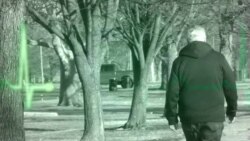Mark Bradford walks through the park by his home every day, but one morning his heart stopped beating and he collapsed in sudden cardiac arrest. The next thing he remembered was waking up in the heart unit at the Ohio State University Wexner Medical Center.
With cardiac arrest, every second counts. The American Red Cross reports that more than 1,600 people suffer a cardiac arrest each day in the U.S.
Survival depends on many factors — how fast a person gets help and what caused the heart to stop.
Studies show that if a bystander starts cardio pulmonary resuscitation, or CPR, which is essentially pumping the chest rhythmically to get the heart started again, or if someone uses a defibrillator within a minute or two after a person's heart stops, the odds of surviving can be as high as 70 percent.
But if the heart quivers uncontrollably and can't pump blood, something called ventricular fibrillation, or if it goes wildly out of rhythm, it will stop beating and chances of survival are slim to none. In these situations, a patient's heart resists being shocked back to normal, and if it does begin beating again, chances are the patient will have permanent disabilities.
"Typically, if they [the patients] don’t respond to getting shocked, these patients would die in the field because we didn’t have any options to save them. Now, in certain situations, we have had patients survive and walk out of the hospital,” Dr. Ernest Mazzaferri Jr. said. Mazzaferri is the medical director of The Ohio State University Richard M. Ross Heart Hospital, which is part of the Wexner Medical Center.
In the U.S., fire departments frequently are called upon to respond to emergencies. When the Columbus, Ohio Fire Department received a new device for CPR, fire fighters contacted the medical center, and the doctors and the fire fighters developed a new plan of action called an ECPR alert.
If a patient's heart resists being shocked back to normal, medics alert the hospital and put a mechanical CPR device on the patient in the ambulance. Meanwhile, a team at the hospital prepares the catheterization laboratory, or cath lab. The lab has diagnostic imaging equipment so doctors can see the heart's arteries and chambers.
Most patients who arrive at a hospital by ambulance go immediately to the emergency room. At Ohio State, patients who have suffered cardiac arrest go immediately to the cath lab. Dr. Ernest Mazzaferri said this protocol iscritically important "because the more time we wait, the more damage is done to the heart and the more damage is done to all of your organs including your brain.”
At the cath lab, the patient is connected to an echmo machine that does the job of the heart and lungs. Dr. Bryan Whitson said this allows the heart and the lungs to rest while doctors work on the heart to try to get it restarted and beating well.
The doctors also try to fix what caused the heart to stop beating. Dr. K. Dean Boudoulas said the new protocol has increased survival rates from the deadliest types of cardiac arrest from zero to 40 percent.
"Patients have a chance to walk out of a hospital with neurological recovery, have a meaningful life, when essentially they would have been pronounced dead in the field."
Bradford was the first patient in Columbus, Ohio, to benefit from this procedure. "Without the protocol, I wouldn't be alive. I am very fortunate that they were trained in it, that they used it, that I was out in the park rather than in the house by myself.”
The ECPR protocol has been tested only in a few small studies, and so far the limited data shows an increase to about a 40 percent chance of survival.
Mazzaferri said the doctors are hopeful the protocol will prove so successful that "perhaps some years from now, ECPR will be more routine and saving more lives across the U.S.”






